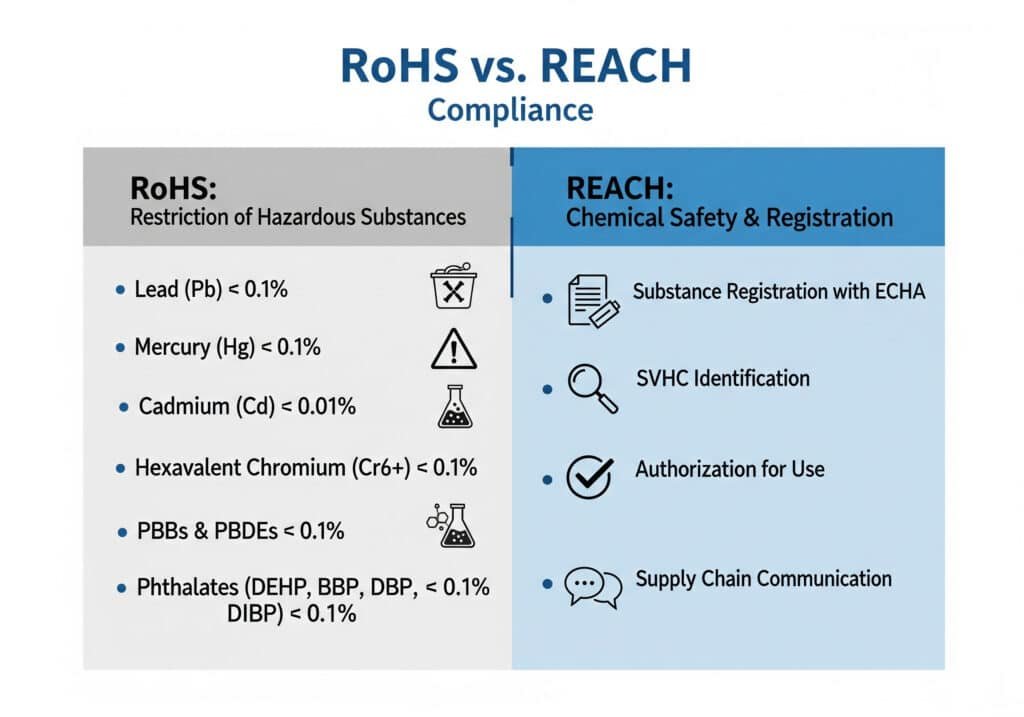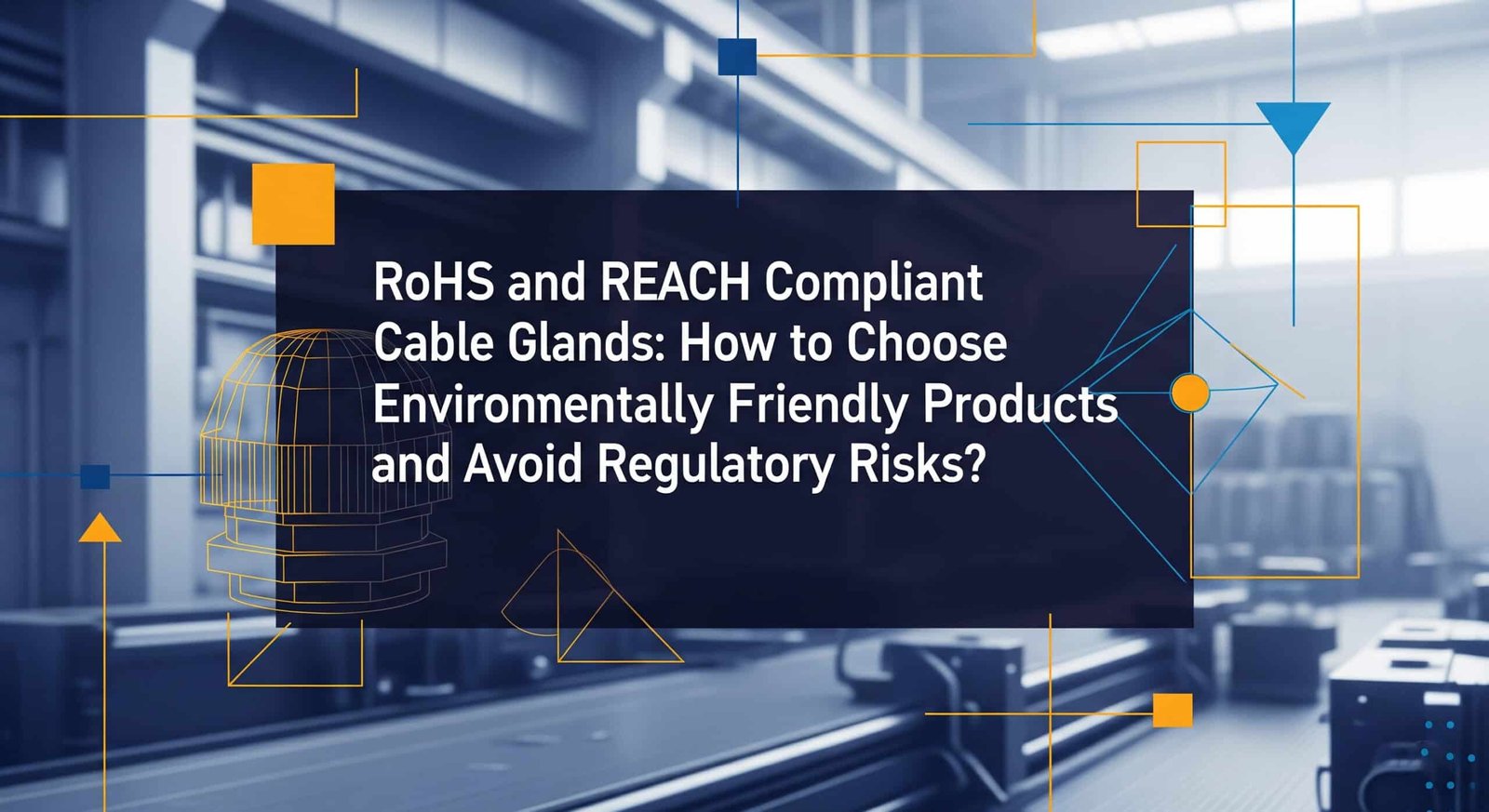Introduction
Picture this: You’ve just received a massive order rejection from a European client, and the reason? Your cable glands don’t meet RoHS compliance standards. The financial loss is devastating, but the damage to your reputation might be even worse. In today’s regulatory landscape, environmental compliance isn’t just a nice-to-have—it’s absolutely critical for business survival.
RoHS and REACH compliant cable glands are electrical connection components that meet strict European environmental regulations by restricting hazardous substances and ensuring chemical safety throughout their lifecycle. These regulations protect human health and the environment while enabling global market access for manufacturers and distributors.
As someone who’s been in the cable gland industry for over a decade, I’ve witnessed countless companies struggle with compliance issues. The good news? With the right knowledge and reliable suppliers like us at Bepto, you can navigate these regulations confidently and turn compliance into a competitive advantage. 😉
Table of Contents
- What Are RoHS and REACH Regulations for Cable Glands?
- Why Is Compliance Critical for Your Business?
- How to Identify Compliant Cable Glands?
- What Should You Look for in a Reliable Supplier?
- FAQs About RoHS and REACH Compliant Cable Glands
What Are RoHS and REACH Regulations for Cable Glands?
Understanding these regulations is your first line of defense against costly compliance failures. Let me break down what you’re dealing with in practical terms.
RoHS (Restriction of Hazardous Substances)1 limits ten specific dangerous materials in electrical equipment, while REACH (Registration, Evaluation, Authorization and Restriction of Chemicals)2 requires comprehensive chemical safety data for all substances used in manufacturing.

RoHS Compliance Requirements
RoHS 3 (Directive 2011/65/EU) restricts these substances in cable glands:
- Lead (Pb) – Maximum 0.1% by weight
- Mercury (Hg) – Maximum 0.1% by weight
- Cadmium (Cd) – Maximum 0.01% by weight
- Hexavalent chromium (Cr6+) – Maximum 0.1% by weight
- Polybrominated biphenyls (PBB) – Maximum 0.1% by weight
- Polybrominated diphenyl ethers (PBDE) – Maximum 0.1% by weight
- Four additional phthalates (DEHP, BBP, DBP, DIBP) – Maximum 0.1% each
REACH Regulation Impact
REACH affects cable glands through:
- Substance registration: All chemicals must be registered with ECHA
- SVHC identification: Substances of Very High Concern3 require special handling
- Authorization requirements: Some substances need explicit permission for use
- Communication obligations: Supply chain transparency is mandatory
I remember working with David, a procurement manager from a major German automotive supplier. He was initially frustrated by the complexity but quickly realized that our comprehensive documentation saved him weeks of regulatory research. “Chuck, your REACH compliance reports are more detailed than what our legal team produces!” he told me during our last video call.
Why Is Compliance Critical for Your Business?
The stakes couldn’t be higher in today’s regulatory environment. Non-compliance isn’t just about fines—it’s about market access and business survival.
Compliance ensures legal market access, protects against financial penalties, maintains customer trust, and provides competitive advantages in environmentally conscious markets.
Financial Risk Assessment
| Risk Category | Potential Impact | Mitigation Strategy |
|---|---|---|
| Market Rejection | €50,000-500,000+ per incident | Pre-qualified compliant suppliers |
| Regulatory Fines | €10,000-100,000+ | Comprehensive documentation |
| Product Recalls | €100,000-1M+ | Third-party testing verification |
| Reputation Damage | Immeasurable | Proactive compliance programs |
Real-World Consequences
Hassan, who owns a chemical processing facility in the Netherlands, learned this lesson the hard way. His previous supplier provided cable glands with questionable REACH documentation. When audited, he faced potential €75,000 in fines and had to replace all non-compliant components within 30 days. “The stress nearly killed me,” he admitted. “Now I only work with suppliers who provide bulletproof compliance documentation.”
Competitive Advantages
Smart companies use compliance as a differentiator:
- Premium pricing: Compliant products command 10-15% higher prices
- Market expansion: Access to EU, UK, and other regulated markets
- Customer loyalty: Buyers prefer reliable compliance partners
- Risk reduction: Fewer supply chain disruptions
How to Identify Compliant Cable Glands?
Knowing what to look for can save you from costly mistakes and regulatory nightmares.
Look for official certification marks, comprehensive test reports, detailed material declarations, and supplier registration numbers that verify genuine compliance status.
Essential Documentation Checklist
Every compliant cable gland should include:
RoHS Documentation:
- CE marking4 with notified body number
- RoHS Declaration of Conformity
- Third-party test reports (IEC 62321 series5)
- Material composition analysis
- Manufacturing process documentation
REACH Documentation:
- SVHC candidate list declaration
- Safety Data Sheets (SDS) for all materials
- REACH registration numbers
- Supplier REACH compliance statement
- Chemical inventory documentation
Red Flags to Avoid
Watch out for these warning signs:
- Generic certificates without specific product details
- Missing test report dates or laboratory accreditation
- Vague material descriptions (“metal alloy” instead of specific composition)
- Certificates that don’t match your exact product specifications
- Suppliers who can’t provide REACH registration numbers
Verification Best Practices
At Bepto, we recommend this verification process:
- Cross-reference certificate numbers with issuing bodies
- Request batch-specific documentation for large orders
- Verify laboratory accreditation (ISO 17025)
- Check SVHC candidate list updates (published twice yearly)
- Maintain documentation archives for audit purposes
What Should You Look for in a Reliable Supplier?
Your supplier choice determines your compliance success. Here’s what separates the professionals from the pretenders.
Choose suppliers with established quality systems, comprehensive testing capabilities, transparent documentation processes, and proven track records in regulated markets.
Supplier Qualification Criteria
| Qualification Area | Must-Have Requirements | Bepto’s Advantage |
|---|---|---|
| Quality Systems | ISO 9001, IATF 16949 | ✅ Both certifications |
| Testing Capabilities | In-house or certified labs | ✅ Accredited lab partnerships |
| Documentation | Real-time compliance tracking | ✅ Digital compliance portal |
| Market Experience | 5+ years in regulated markets | ✅ 10+ years EU market experience |
Our Compliance Infrastructure
At Bepto, we’ve invested heavily in compliance infrastructure:
- Advanced material testing: XRF analyzers for real-time substance detection
- Supply chain audits: Regular supplier compliance verification
- Documentation systems: Automated compliance report generation
- Regulatory monitoring: Continuous updates on changing requirements
- Customer support: Dedicated compliance specialists
Partnership Benefits
Working with established suppliers like us provides:
- Risk sharing: We assume compliance liability with proper documentation
- Expertise access: Our regulatory team stays current on changing requirements
- Cost efficiency: Bulk testing and certification reduce per-unit costs
- Speed to market: Pre-qualified products eliminate compliance delays
Remember David from earlier? After switching to Bepto, his procurement cycle shortened from 8 weeks to 3 weeks because our pre-certified products eliminated his internal compliance review process. “You’ve made my job so much easier, Chuck. My boss thinks I’m a procurement genius now!” 😉
Conclusion
Navigating RoHS and REACH compliance doesn’t have to be overwhelming when you have the right knowledge and partners. The key is understanding that compliance is an investment in your business’s future, not just a regulatory burden. By choosing certified products from reliable suppliers, maintaining proper documentation, and staying informed about regulatory changes, you protect your business while opening doors to premium markets. At Bepto, we’re committed to making compliance simple and straightforward for our customers, because your success is our success.
FAQs About RoHS and REACH Compliant Cable Glands
Q: What’s the difference between RoHS and REACH compliance for cable glands?
A: RoHS restricts specific hazardous substances in electrical equipment, while REACH requires comprehensive chemical safety data for all materials used. Both are mandatory for EU market access but cover different aspects of environmental safety.
Q: How often do RoHS and REACH regulations change?
A: RoHS updates occur every few years with new substance restrictions, while REACH updates twice yearly with new SVHC candidates. Suppliers should monitor both regulatory calendars and update documentation accordingly.
Q: Can I use the same compliance certificate for different cable gland models?
A: No, each cable gland model requires specific compliance documentation based on its unique materials and construction. Generic certificates don’t provide adequate regulatory protection for specific products.
Q: What happens if my cable glands fail compliance testing after purchase?
A: You may face market withdrawal requirements, regulatory fines, and customer claims. Choose suppliers who guarantee compliance and provide comprehensive insurance coverage for non-conforming products.
Q: How much more do compliant cable glands cost compared to non-compliant ones?
A: Compliant cable glands typically cost 10-20% more initially, but this premium is offset by avoiding regulatory risks, market access benefits, and customer preference for certified products.
-
Review the official legislation and guidance on the Restriction of Hazardous Substances from the European Commission. ↩
-
Explore the official framework for the Registration, Evaluation, Authorization, and Restriction of Chemicals from ECHA. ↩
-
Access the current official list of Substances of Very High Concern that may require authorization under REACH. ↩
-
Learn about the conformity assessment procedures and requirements to affix the CE mark on products sold in the EU. ↩
-
Understand the internationally recognized standard test methods for determining levels of regulated substances in electrotechnical products. ↩



